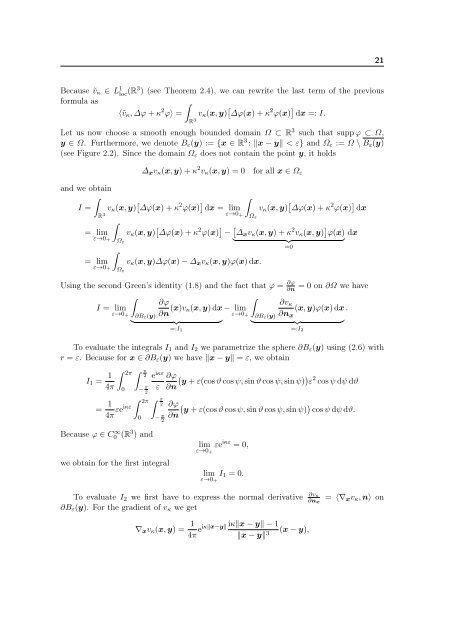The Boundary Element Method for the Helmholtz Equation ... - FEI VÅ B
The Boundary Element Method for the Helmholtz Equation ... - FEI VÅ B
The Boundary Element Method for the Helmholtz Equation ... - FEI VÅ B
Create successful ePaper yourself
Turn your PDF publications into a flip-book with our unique Google optimized e-Paper software.
21Because ṽ κ ∈ L 1 loc (R3 ) (see <strong>The</strong>orem 2.4), we can rewrite <strong>the</strong> last term of <strong>the</strong> previous<strong>for</strong>mula as⟨ṽ κ , ∆ϕ + κ 2 ϕ⟩ = v κ (x, y) ∆ϕ(x) + κ 2 ϕ(x) dx =: I.R 3Let us now choose a smooth enough bounded domain Ω ⊂ R 3 such that supp ϕ ⊂ Ω,y ∈ Ω. Fur<strong>the</strong>rmore, we denote B ε (y) := {x ∈ R 3 : ∥x − y∥ < ε} and Ω ε := Ω \ B ε (y)(see Figure 2.2). Since <strong>the</strong> domain Ω ε does not contain <strong>the</strong> point y, it holds∆ x v κ (x, y) + κ 2 v κ (x, y) = 0<strong>for</strong> all x ∈ Ω εand we obtainI = v κ (x, y) ∆ϕ(x) + κ 2 ϕ(x) dx = lim v κ (x, y) ∆ϕ(x) + κ 2 ϕ(x) dxR 3 ε→0 + Ω ε= lim v κ (x, y) ∆ϕ(x) + κ 2 ϕ(x) − ∆ x v κ (x, y) + κ 2 v κ (x, y) ϕ(x) dxε→0 + Ω ε =0= lim v κ (x, y)∆ϕ(x) − ∆ x v κ (x, y)ϕ(x) dx.ε→0 + Ω εUsing <strong>the</strong> second Green’s identity (1.8) and <strong>the</strong> fact that ϕ = ∂ϕ∂n= 0 on ∂Ω we haveI = lim∂ϕ∂n (x)v κ(x, y) dx − lim =:I 1ε→0 +∂B ε(y)∂v κ(x, y)ϕ(x) dx .∂n x =:I 2ε→0 +∂B ε(y)To evaluate <strong>the</strong> integrals I 1 and I 2 we parametrize <strong>the</strong> sphere ∂B ε (y) using (2.6) withr = ε. Because <strong>for</strong> x ∈ ∂B ε (y) we have ∥x − y∥ = ε, we obtainI 1 = 1 2π π24π 0 − π 2= 14π εeiκε 2π0e iκεε π2− π 2∂ϕ y + ε(cos ϑ cos ψ, sin ϑ cos ψ, sin ψ) ε 2 cos ψ dψ dϑ∂n∂ϕ y + ε(cos ϑ cos ψ, sin ϑ cos ψ, sin ψ) cos ψ dψ dϑ.∂nBecause ϕ ∈ C ∞ 0 (R3 ) andwe obtain <strong>for</strong> <strong>the</strong> first integrallim εe iκε = 0,ε→0 +limε→0 +I 1 = 0.To evaluate I 2 we first have to express <strong>the</strong> normal derivative ∂vκ∂n x∂B ε (y). For <strong>the</strong> gradient of v κ we get= ⟨∇ x v κ , n⟩ on∇ x v κ (x, y) = 1 iκ∥x − y∥ − 1eiκ∥x−y∥4π ∥x − y∥ 3 (x − y),









